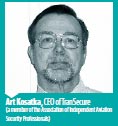Government In volvement
As most airports are state-owned, municipal, state and federal governments are crucial players in determining what security measures need to be set up in airports. “There is a maze of security and regulatory issues facing every airport,” said John Diedam, VP of International Sales, Ingersoll Rand Security Technologies. “It starts with a thorough understanding of Title 49 CFR Part 1542 of the US Homeland Security's Transportation Department, ranging from who must be in charge, how to become compliant and airport tenant security programs, to security of various locations within the airport, law enforcement and access control. The first objective is to reduce the complexity of this and all other pertaining regulations, along with the security ramifications.”
Next, one needs to determine and resolve airport security and fire safety vulnerabilities, Diedam continued. “Security could be almost perfect if everything was locked down and nobody could come or go, but that's not feasible. What needs to be done is to assure that security is at a high level but innocents can escape when needed. There's a compromise, and they are typically found within the regulations aforementioned and local codes and regulations.”
 In the U.S., every commercial airport is owned and operated by a local government entity — city, county, state or port authority — each with its own political structure, funding capabilities, environmental/noise requirements and security/law enforcement support, said Art Kosatka, CEO of TranSecure (a member of the Association of Independent Aviation Security Professionals). “There are federal regulations, as well as state and local building and electrical codes and fire and life safety codes, which must be met.”
In the U.S., every commercial airport is owned and operated by a local government entity — city, county, state or port authority — each with its own political structure, funding capabilities, environmental/noise requirements and security/law enforcement support, said Art Kosatka, CEO of TranSecure (a member of the Association of Independent Aviation Security Professionals). “There are federal regulations, as well as state and local building and electrical codes and fire and life safety codes, which must be met.”
“We often see that local or state governments are strongly involved in the economic development of the region/country where the airport is situated,” Bouter said. “Under such circumstance, local solution providers are often favored to take on new or upgrade projects.”
Airports are used as hubs to create new business in many places, observed Gerard Otterspeer, Product Marketing Manager for CCTV, Bosch Security Systems. “At times, international consultants such as ADPI, COWI-Larsen, Bechtel and Parsons set the security standards in airport projects while they help clients plan and design aviation construction projects.”
New ≠ Best
While there are strict and high security requirements, not all airport projects use the latest technologies the security industry has to offer. “Airport clients are very savvy customers, knowing what they need and insisting that their integrators and manufacturers provide systems that meet their expectations for both performance and budget,” Wilson said. “With even new construction projects, it is not unusual to see analog video implanted in areas where it sufficiently does the job. In fact, there are many hybrid and coexisting systems at airports.” 
“Airports focus on leveraging as much of their existing technology as possible; they do not have a rip-andreplace mentality,” said James Chong, CTO of VidSys. “Additionally, they tend to wait to use new technology until it has been proven in the marketplace.”
“Generally, we like to think in terms of first providing an initial concept of operations (ConOps) for the customer — what are you doing, why do you need it, where is it required, what is the threat you are addressing and what are the priorities,” Kosatka said. “This should drive the technology decisions, one of which might be that new technology in consideration isn't right for the airport's actual needs at all.” 
Securing airports is a complex undertaking, remarked Larry Lien, VP of Product Management at Proximex (an ADT Security Services company). “Airports are continuously looking for ways to improve ConOps to best protect passengers and employees, as well as avoid poor publicity and lost revenue from security incidents. Some airports leverage the latest technologies to fit specific project requirements. They evaluate many factors to make the decisions, including the benefits, risk factors, costs and ROI for new technologies. Newer technologies, such as HD cameras, offer significant advantages because airports may leverage fewer cameras but still cover a large area. However, airports must still consider the ability of newer technologies to communicate with existing systems and fit within the ConOps.”
In airport projects, proven brands, solutions and products are preferred, while current technologies are followed in a general fashion, Otterspeer observed. “HD and even full HD products have gained popularity in this kind of projects for applications like forensic search and wide-angle viewing; however, during the course of a project, the technologies used can change.” Technologies used are much influenced by the consultants in many cases.